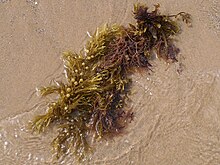Sargassum muticum
| Sargassum muticum | ||||||||||||
|---|---|---|---|---|---|---|---|---|---|---|---|---|

Sargassum muticum |
||||||||||||
| Systematics | ||||||||||||
|
||||||||||||
| Scientific name | ||||||||||||
| Sargassum muticum | ||||||||||||
| ( Yendo ) Fensholt |
Sargassum muticum is a species of brown algae from the genus of the golf rod . Originally from Japan, the highly invasive species has spread rapidly in the North Atlantic, the North Sea and the Baltic Sea in recent years.
description
Sargassum muticum is a perennial seaweed . In its native Japan, it grows to around 1 to 3 m tall, but outside of its natural range it can reach 10 to 16 m in length and then form flooding mats on the surface of the sea. Its bushy thallus consists of dark brown main axes with alternate olive-brown side branches that carry leaf-like phylloids . The phylloids are elongated in the lower part of the thallus, linear-lanceolate and up to 10 cm long, in the upper parts narrow and only about 4 mm long. The edge of the phylloids is smooth or irregular, roughly serrated to notched. The seaweed has numerous stalked, gas-filled floats from ovoid to inverted teardrop-shaped with a diameter of 2 to 4 mm and a smooth surface. The number of these gas bubbles increases during the summer.
development
The main axis of the kelp can live around 3 to 4 years and grow up to 10 cm daily. The lighter side branches are shed in autumn. The reproduction takes place both sexually and vegetatively via drifted parts of the thallus. In the early autumn, the germ cells are formed by the thousands in cylindrical-cone-shaped receptacles in the axils of the branches. The fertilized zygotes usually settle in the vicinity of the parent thallus and quickly form dense Sargassum mats. Since torn pieces of thallus also release germ cells when they drift, the species spreads effectively.
Occurrence
Sargassum muticum is native to the coast of Japan . It is highly invasive and has now spread from the Northwest Pacific to much of the North Pacific and North Atlantic . In the north-east Atlantic it occurs from Norway to Spain , also in the North Sea and Baltic Sea as well as in the Mediterranean Sea . It can be found in the northeast Pacific from Alaska to California .
The species was first found in Europe in 1973 on the Isle of Wight , but it is believed that it has appeared on the coast of France since 1966 . Since then, it has spread to almost all European coasts by means of oyster transports or the direct transfer of parts of thallus to ships. It was detected on Germany's coasts from 1988.
Sargassum muticum inhabits different habitats from tidal pools in the intertidal zone to the sublittoral , where it penetrates to a depth of 3 to 5 m below the low water line.
Effects of the invasive kind
Where Sargassum mats predominate in Europe, they can hinder boat traffic or swimmers, or they can be washed up on the beach in large quantities as lumps that are difficult to rot. Above all, however, they reduce the incidence of light and thereby displace native species in benthos , such as sugar kelp ( Saccharina latissima ), belt kelp ( Himanthalia elongata ) or seaweed ( Zostera marina ). Therefore, a decline in biodiversity due to this alien species ( neobiota ) is feared. In some regions that are only sparsely populated with algae, it could also offer additional habitat for fish or crustaceans.
Systematics
It was first described in 1907 by Kitchisuburo Yendo under the name Sargassum kjellmanianum f. muticum Yendo (in: The Fucaceae of Japan . Journal of the College of Science, Tokyo Imperial University 21, p. 104.) Dorothy E. Fensholt gave the clan the status of a separate species as Sargassum muticum (Yendo) Fensholt in 1955 (in: An emendation of the genus Cystophyllum (Fucales) . American Journal of Botany 42: p. 306).
Sargassum muticum belongs to within the genus Sargassum ( Sargassum ) for subgenus Bactrophycus , section Teretia . The genus belongs to the family Sargassaceae in the order of the Fucales .
swell
- Wolfram Braune: marine algae. A color guide to the common benthic green, brown and red algae of the world's oceans . Ruggell: Gantner, 2008, ISBN 978-3-906166-69-8 , pp. 254-255. (Sections Description, Occurrence)
- Michael D. Guiry, GM Guiry: Sargassum muticum - In: Algaebase - World-wide electronic publication, National University of Ireland, Galway , accessed April 23, 2012 (sections systematics, occurrence)
Individual evidence
- ↑ a b c d Michael Guiry: The Seaweed Site: information on marine algae: Sargassum muticum , accessed April 23, 2012.
- ↑ Aquatic alien species in German inland and coastal waters ( Memento of the original from January 21, 2012 in the Internet Archive ) Info: The archive link has been inserted automatically and has not yet been checked. Please check the original and archive link according to the instructions and then remove this notice. , accessed April 23, 2012.
